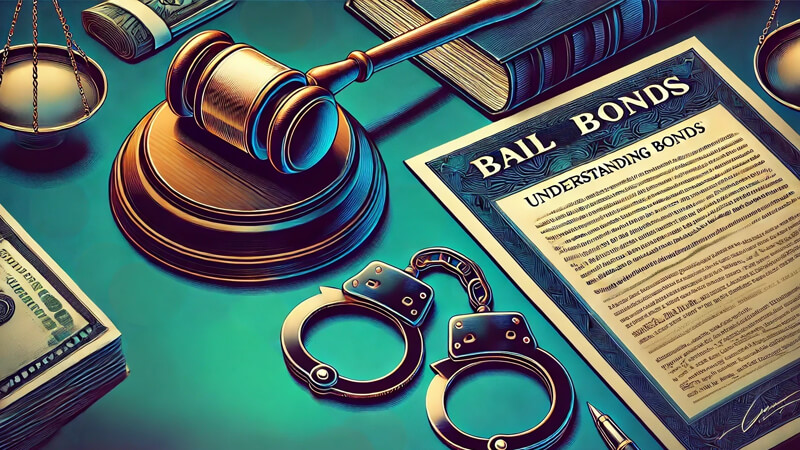Comprehending the Basics of Bail Bonds: What You Required to Know
Browsing the complexities of bail bonds is an important facet of the lawful system that can significantly affect the accused's trip via court process. A bail bond functions as an economic guarantee for the court, promoting momentary release from wardship while waiting for test. The intricacies of exactly how bail bonds operate, the different kinds available, and the essential considerations in selecting a trustworthy bail bondsman can be intimidating. Comprehending these elements is vital, as the effects of mistakes may lead to unanticipated issues that prolong far past the court. What are the fundamental facets that a person must understand to effectively steer this process?
What Is Bail?
Bail is an economic setup that enables a specific accused of a crime to be launched from custody while waiting for test. The key purpose of bail is to make sure that the defendant stands for future court procedures (Los Angeles Bail Bondsman). Generally established by a court, the bail amount varies relying on the nature of the criminal offense, the offender's criminal background, flight danger, and other pertinent variables
When bail is provided, the accused or a rep should pay a specified sum, which might remain in cash or through a bail bond. Sometimes, bail can be denied completely, particularly for major offenses or if the suspicious postures a considerable danger to public safety. The principle of bail is rooted in the assumption of innocence, reinforcing the concept that people need to not be punished prior to a conviction.

Recognizing Bail Bonds
A bail bond is a monetary tool that facilitates the launch of an accused person from protection, acting as a guarantee for their appearance at future court days. This plan permits defendants to keep their flexibility while waiting for test, decreasing the burdens related to imprisonment. The bail bond procedure commonly involves a third-party firm, referred to as a bond bondsman, that provides the needed funds to the court in support of the accused.
Bail bonds come in different kinds, including surety bonds, residential property bonds, and cash money bonds, each with unique demands and ramifications. Surety bonds, one of the most typical type, call for a superior payment, typically a percentage of the total bail amount, which is non-refundable. On the other hand, a home bond involves utilizing property as collateral, while cash bonds demand the full bail quantity to be paid upfront.
Understanding the subtleties of bail bonds is critical for defendants and their family members. It is important to comprehend the possible monetary effects, including charges and commitments to the bail bondsmansman, in addition to the lawful responsibilities linked to making certain court looks. Understanding of these aspects help in making informed choices throughout a tough time.
How Bail Bonds Work
The procedure of securing a bail bond commonly includes several essential actions that ensure the accused can reclaim their freedom while awaiting trial. The specific or their depictive get in touches with a bond bondsman, who analyzes the case and the linked dangers. The bail bondsman will require information regarding the implicated, consisting of the fees, the bail amount set by the court, and any type of appropriate individual details.
When the bondsman agrees to offer the bond, the charged or their agent has to pay a non-refundable cost, generally a percentage of the overall bail amount. This cost makes up the bail bondsman for taking on the financial risk of making certain the charged appears in court. In many cases, collateral might additionally be required, such as their website residential or commercial property or beneficial properties, which acts as protection for the bond.
After any kind of collateral and the charge are organized, the bail bondsman sends the required paperwork to the court. Upon approval, the bail is posted, and the charged is released from wardship. It is vital for the charged to stick to all court dates and conditions, as failure to do so can lead to the loss of the bond and potential legal consequences.
Sorts Of Bail Bonds
Various sorts of bail bonds are available to match different circumstances and demands. The most typical type is the guaranty bond, where a bond bondsman guarantees settlement of the complete bail More Help amount to the court in exchange for a non-refundable cost, normally around 10% of the bail. This arrangement permits accuseds to safeguard their release without paying the whole bail upfront.
An additional kind is the cash money bond, which calls for the offender or a co-signer to pay the complete bail amount in money directly to the court - Bail Bonds. This alternative is typically chosen for reduced bail quantities, as it guarantees the cash is returned upon the offender's look in all court proceedings
Building bonds include the use of realty as collateral. In this situation, the court puts a lien on the residential or commercial property, which can be surrendered if the accused falls short to show up.
Last but not least, government bail bonds are particularly designed for federal instances, commonly entailing greater quantities and additional intricacies. Comprehending these different bail bond kinds is vital for offenders and their family members in making notified decisions during a difficult time.
Picking a Bond Bondsman
When picking a bondsman, it is necessary to take into consideration several crucial elements that can influence the total experience and end result. Evaluate the bondsman's reputation by investigating on the internet evaluations and acquiring suggestions from trusted resources. A reliable bail bondsmansman will certainly have a background of professionalism and successful situations.

Many bail bondsmen bill a non-refundable charge, usually around 10% of the bail amount. Transparency in rates is a hallmark of a credible bail bondsman.
Conclusion
In summary, comprehending the fundamentals of bail bonds is necessary for people associated with the lawful system. Bail acts as a monetary assurance of court appearance, while numerous kinds of bail bonds satisfy various scenarios. Understanding the operational systems of bail bonds and choosing a trusted bail bondsmansman can considerably influence the overall experience. A comprehensive examination of offered alternatives makes certain informed decision-making, ultimately facilitating a smoother navigation through the intricacies of the legal process.
The intricacies of just how bail bonds operate, the various types readily available, and the important considerations in selecting a reputable bail bondsman can be discouraging. The bail bond procedure generally entails a third-party company, recognized as a bond bondsman, that provides the needed funds to the court on part of the charged.
The most common kind is the guaranty bond, where a bail bondsman guarantees payment of the full bail amount to the court in exchange for a non-refundable fee, commonly around 10% of the bail. Bail offers as a financial guarantee of court look, while different kinds of bail bonds provide to various scenarios. Comprehending the operational mechanisms of bail bonds and selecting a respectable bail bondsman can considerably affect the total experience.